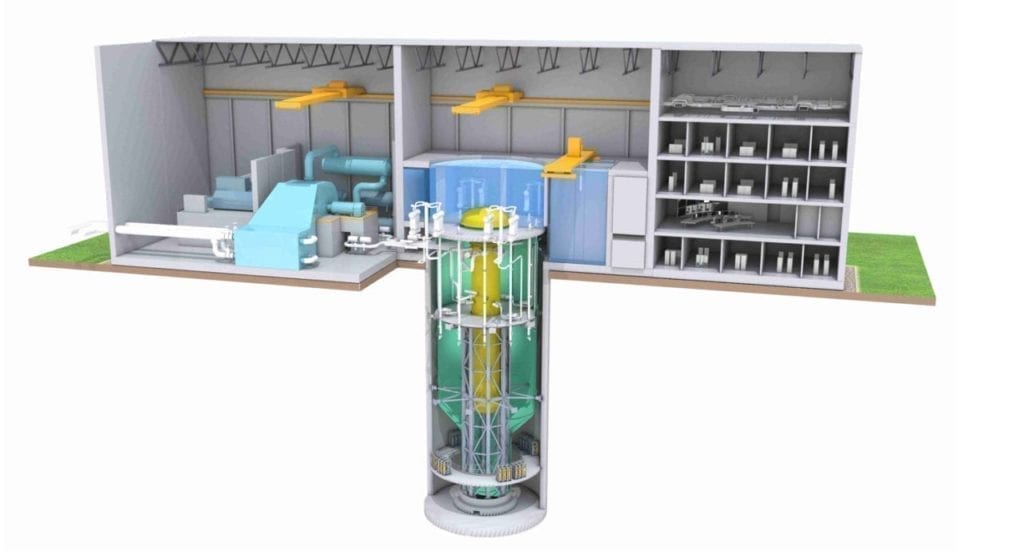GE Hitachi Advances Collaboration to Bolster BWRX-300 SMR Deployment in Estonia
GE Hitachi Nuclear Energy (GEH) and Estonian firm Fermi Energia OÜ have entered into a teaming agreement to support potential deployment of a BWRX-300 small modular reactor (SMR) in the Baltic country.
The agreement between the technology company and the firm established in 2019 by nuclear industry professionals comes two years after the companies inked a memorandum of understanding (MOU) to examine the economic feasibility of deploying a 300-MWe BWRX-300 SMR in Estonia.
“Through the teaming agreement GEH expects to support Fermi Energia in key areas such as licensing, human resources and supply chain development as well as continued development of the information and analysis needed for potential deployment of the BWRX-300 in Estonia,” GEH said on March 8.
The development is another notable step for Fermi Energia, which has conducted feasibility studies for several SMR technologies along with the BWRX-300. These include Moltex Energy’s 300-MWe Stable Salt Reactor (SSR), NuScale’s small light water reactor modules; Terrestrial’s IMSR-400, a 195-MWe Generation IV nuclear technology that uses a molten fluoride salt; and Ultra Safe Nuclear Corp.’s 5-MWe (15 MWth) Micro Modular Reactor (MMR) design.
Fermi Energia CEO Kalev Kallemets told POWER on March 8 that the company’s strategy, for the sake of “conservatism and competitiveness,” is to make a final selection after first-of-a-kind (FOAK) completions, and before submittal of a construction permit application to the Estonian regulator. “We hope by 2028,” he said. “Likely we would down-select from the current four to six designs to two to three by 2026, when we would submit an application for the Decision in Principle.”
Estonia Grasping for Solid Energy Footing
The BWRX-300 is the 10th evolution of GE’s boiling water reactor (BWR) technology, and GEH says it represents “the simplest, yet most innovative BWR design since GE began developing nuclear reactors in 1955.” On its website, GEH also notes that the design is based on the Gen III+ 1,520-MW ESBWR, which the U.S. Nuclear Regulatory Commission certified in 2014.

Fermi Energia says an SMR is well-suited to Estonia, a small European Union (EU) member, because it provides a cost-effective alternative to large nuclear plant construction, while also bolstering Estonia’s national security and decarbonization initiatives.
Estonia has sought pathways to decarbonize its energy supplies since 2017, when it set a long-term goal to reduce greenhouse gas emissions by almost 80% by 2050 compared to 1990 levels. So far, the country’s government has committed to exit oil-shale power generation by 2035. It is looking to replace some of that power by forming a national nuclear energy working group. Part of the nation’s urgency to develop a domestic nuclear segment is spurred by its ambitions to seek energy independence from Russia. It is collaborating, for example, with Latvia and Lithuania to desynchronize from the Russian grid system and effectively end power imports from Russia by December 2025.
Fermi’s Crucial Partnerships
Earlier this year, Fermi Energia closed a €2.5 million capital raise—mostly from Estonian investors—to submit a “National Designated Spatial Planning” application to the government. According to Kallemets, the firm continues “to develop, in greater detail, decision material for a credible National Spatial Plan and help Estonia meet climate goals while maintaining security of supply of energy for Estonians and the region.”In tandem, Fermi Energia has been making headway in developing crucial partnerships to enable SMR construction. It recently signed Letters of Intents with European nuclear firms, Tractebel Engineering SA, Vattenfall, and Fortum to cooperate “over coming years on several technical, regulatory, human resource and economic studies to prepare appropriate siting and apply for decision in principle by Estonian government.” Belgian engineering firm Tractebel, notably, is reportedly mulling becoming a shareholder in Fermi.
On March 2, the company also signed an MOU with UK firm Rolls-Royce to study all aspects of SMR deployment, including grid suitability, cooling, emergency planning, human resources, licensing feasibility, economics and supply chain.“Fermi Energia is looking at SMR designs with credible technical, financial and political commitment to have First-of-a-Kind deployment this decade. Rolls-Royce SMR certainly fits the bill with strong UK government commitment on carbon neutrality and nuclear energy with appropriate national financing on Rolls-Royce SMR development,” said Kallemets. “Fermi Energia will consider Rolls-Royce SMR as one of the credible SMR designs in its national designated spatial planning procedure.”
Meanwhile, in February, Fermi Energia held a day-long conference to explore its options concerning licensing models, nuclear fuel and waste management, industrial uses for nuclear power, site screening for SMRs, and the speed at which an SMR could be built in Estonia.
During that conference, Claes Andersson, senior specialist at Swedish energy group Vattenfall suggested the BWRX-300 “enables a way to build SMRs in Estonia quickly,” owing to GEH’s earlier reactor development, and its simple processes and systems. The BWRX-300, which is pursuing licensing activities in the U.S., Canada, the UK, and Poland, will be deployable by 2028, he noted. Pre-construction could take 48 months for the first unit, while construction could span 36 months for the first unit, and 24 months for following units, he suggested.
At the conference, Chris Parker, managing director for nuclear waste firm Deep Isolation, unveiled a preliminary study that suggests a deep borehole repository for nuclear waste in Estonia would be both a “safe and affordable” option.
—Sonal Patel is a POWER senior associate editor (@sonalcpatel, @POWERmagazine).